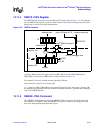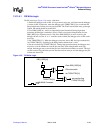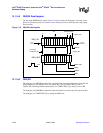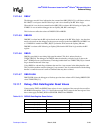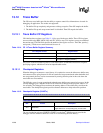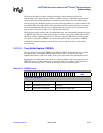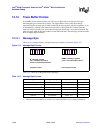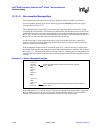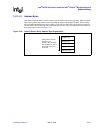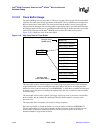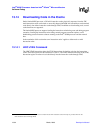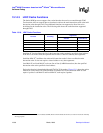
Developer’s Manual March, 2003 13-29
Intel
®
80200 Processor based on Intel
®
XScale
™
Microarchitecture
Software Debug
13.13.1.1 Exception Message Byte
When any kind of exception occurs, an exception message is placed in the trace buffer. In an
exception message byte, the message type bit (M) is always 0.
The vector exception (VVV) field is used to specify bits[4:2] of the vector address (offset from the
base of default or relocated vector table). The vector allows the host SW to identify which
exception occurred.
The incremental word count (CCCC) is the instruction count since the last control flow change (not
including the current instruction for undef, SWI, and pre-fetch abort). The instruction count
includes instructions that were executed and conditional instructions that were not executed due to
the condition of the instruction not matching the CC flags.
A count value of 0 indicates that 0 instructions executed since the last control flow change and the
current exception. For example, if a branch is immediate followed by a SWI, a direct branch
exception message (for the branch) is followed by an exception message (for the SWI) in the trace
buffer. The count value in the exception message is 0, meaning that 0 instructions executed after
the last control flow change (the branch) and before the current control flow change (the SWI).
Instead of the SWI, if an IRQ was handled immediately after the branch (before any other
instructions executed), the count would still be 0, since no instructions executed after the branch
and before the interrupt was handled.
A count of 0b1111 indicates that 15 instructions executed between the last branch and the
exception. In this case, an exception was either caused by the 16th instruction (if it is an undefined
instruction exception, pre-fetch abort, or SWI) or handled before the 16th instruction executed (for
FIQ, IRQ, or data abort).



